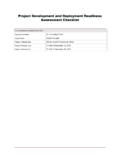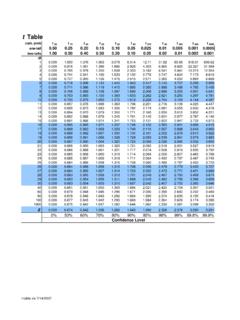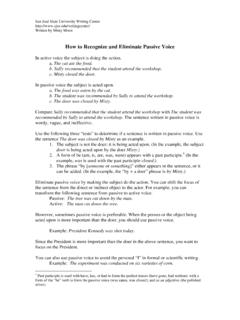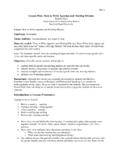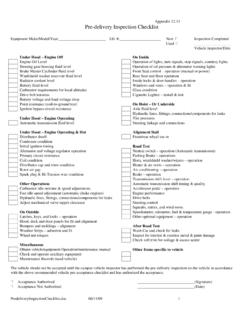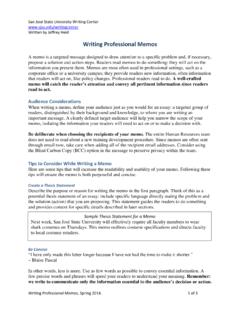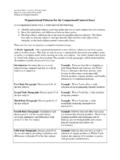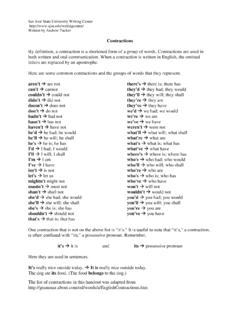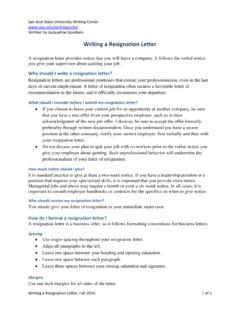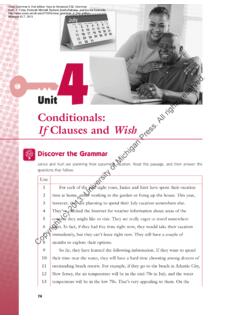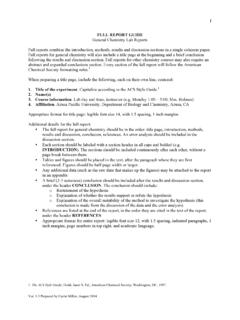Transcription of Lay vs. Lie - San Jose State University
1 San Jos State University Writing Center Written by Alyssa Galvan Lay vs. Lie Present Tense past Tense past Participle (takes the helping verb has, have, . or had ). Lay Laid Laid Lie Lay Lain The Present Tense A. To lay is a transitive verb that requires a direct object. In other words, something or someone is receiving the action. The action of the verb is being transferred from the actor to the direct object. Examples of Lay in the Present Tense 1. I lay the keys on the table. 2. You lay the laptop on the desk. In the above examples, the transitive verb lay is followed by the direct objects the keys and the laptop, respectively. B. To lie is an intransitive verb and does not take a direct object. Examples of Lie in the Present Tense 1. I lie on the couch. 2. We lie beside the pool. In the above examples, the intransitive verb lie does not take a direct object.
2 We do not transfer the action across to other people or things. Note: In both sample sentences, lie is followed by a prepositional phrase, not a direct object. The past Tense and past Participle A. The past tense of to lay is laid, and the past participle of to lay is laid. The past participle of to lay takes the helping verb has, have, or had.. Examples of Lay in the past and past Participle tenses 1. Tomas laid his newborn baby in the crib last night. ( past tense). 2. Amber had laid all her money on the nightstand. ( past participle tense). Lay vs. Lie, Spring 2013. Rev. Summer 2014. 1 of 3. In the above examples, the transitive verb lay takes the direct objects his newborn baby and all her money, respectively. Remember that any tense of the transitive verb lay must take a direct object. B. The past tense of to lie is lay, and the past participle is lain.
3 To lie is an intransitive verb and does not have a direct object. Examples of Lie in the past and past Participle tenses 1. Ramona lay in the sun too long yesterday. ( past tense). 2. The cat has lain in my bed since nine o'clock last night. ( past participle tense). In the above examples, the intransitive verb lie does not take any direct objects because the action is not being transferred to anything. Prepositional phrases are not direct objects. Activity 1: Practice with the Present Tense In the following sentences, choose the correct word. If you choose lay, underline the direct object. 1. I lay/lie wide awake tonight. 2. My brother lays/lies his wet clothes out to dry. 3. You lay/lie the book on the chair next to you. 4. We lay/lie the placemats on the table. 5. Will you come lay/lie next to me in the grass?
4 Activity 2: Practice with the past Tense and the past Participle In the following sentences, choose the correct word. If you choose a tense of lay, underline the direct object. 1. Three days ago, Richard laid/lay his headphones on the empty seat next to him. 2. I laid/lay my head on my pillow last night. 3. The dirty laundry laid/lay all over the floor. 4. Cinderella has laid/has lain her gown on the soft bed. 5. Yesterday, Evelyn laid/lay in a field of wildflowers. Activity 3: Practice with the Present Tense, past Tense, and past Participle In the following sentences, choose the correct word. Pay attention to the indicated time to determine which tense you should use. If you choose a tense of lay, underline the direct object. 1. You lay/laid the cards on the table yesterday. 2. Now I lay/lie me down to sleep.
5 3. Last month, as we lay/laid in our beds, we heard a commotion. Lay vs. Lie, Spring 2013. Rev. Summer 2014. 2 of 3. 4. She has lain/has laid beneath the trees since early this morning. 5. My mother lies/lays flowers on my grandmother's grave. Answer Key for Activity 1. 1. lie 2. lays (direct object: his wet clothes). 3. lay (direct object: the book). 4. lay (direct object: the placemats). 5. lie Answer Key for Activity 2. 1. laid (direct object: his headphones). 2. laid (direct object: my head). 3. lay 4. has laid (direct object: her gown). 5. lay Answer Key for Activity 3. 1. laid (direct object: the cards). 2. lay (direct object: me). 3. lay 4. has lain 5. lays (direct object: flowers). Lay vs. Lie, Spring 2013. Rev. Summer 2014. 3 of 3.
